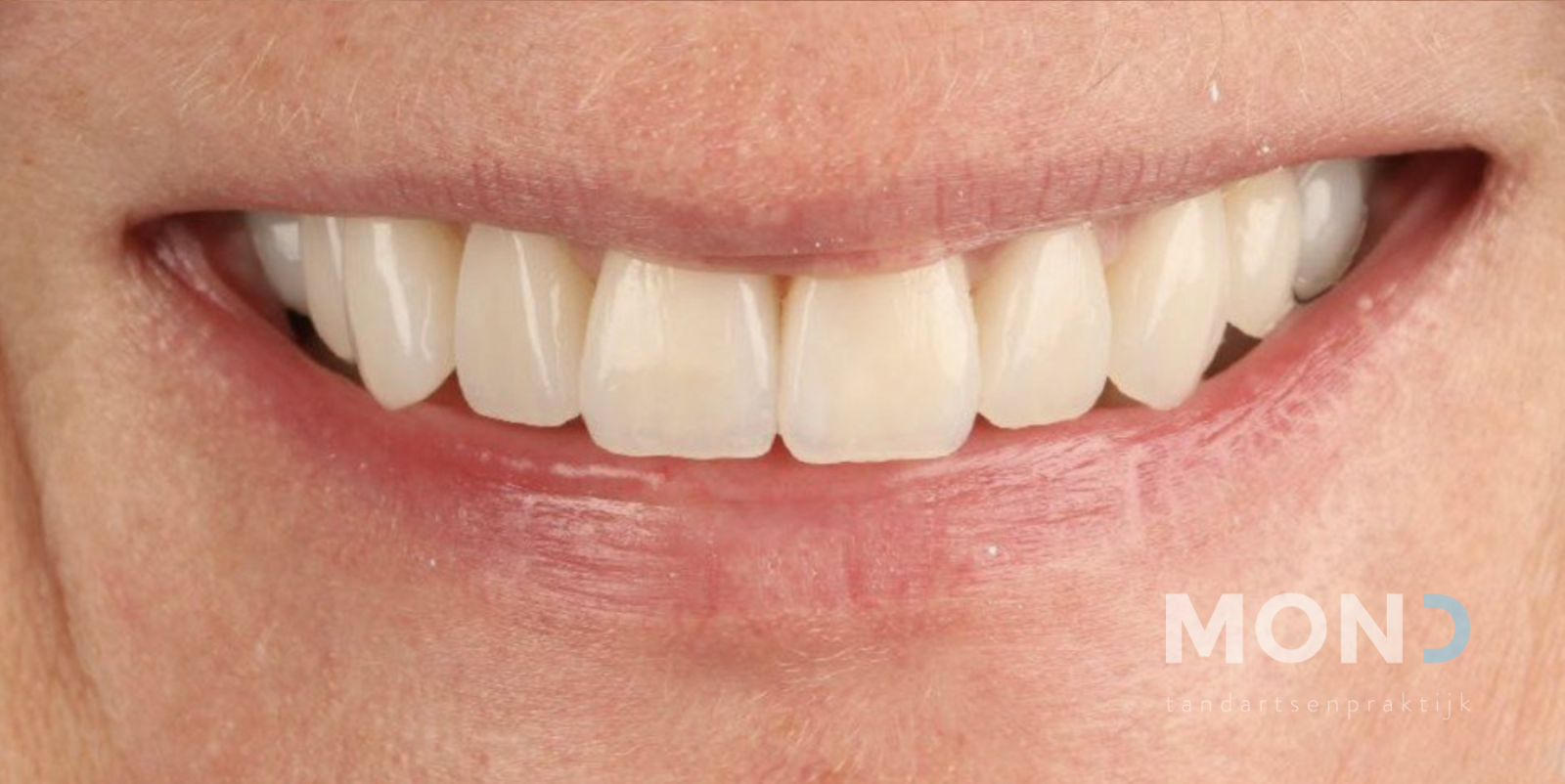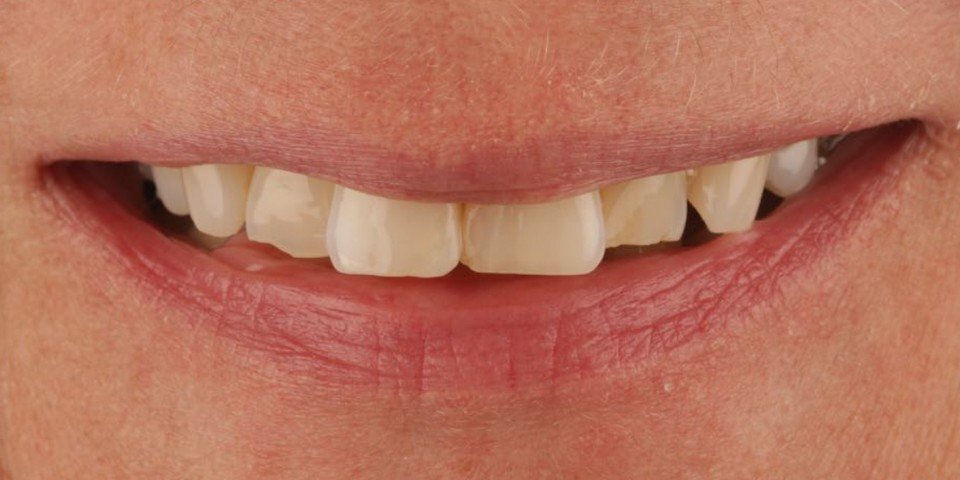Bleaching
Bleaching or teeth whitening is a cosmetic treatment to lighten the colour of your teeth.
How does bleaching work?
As we age, a number of things can cause our teeth to become discoloured. Coffee, tea, red wine and cigarettes are the most common factors for external (visible) discolouration, whereas trauma, fillings, root canals or taking (certain) antibiotics as a child are the most common reasons for internal (invisible) discolouration. Depending on what is causing it, the dentist will determine the best treatment.
External discolourations can usually be removed quite easily with hydrogen peroxide, which has an oxidising effect. This product forms a bond with the pigments that cause the teeth to become discoloured, making them lighter in colour. Depending on the extent of the discolouration, the treatment is likely to be repeated several times.
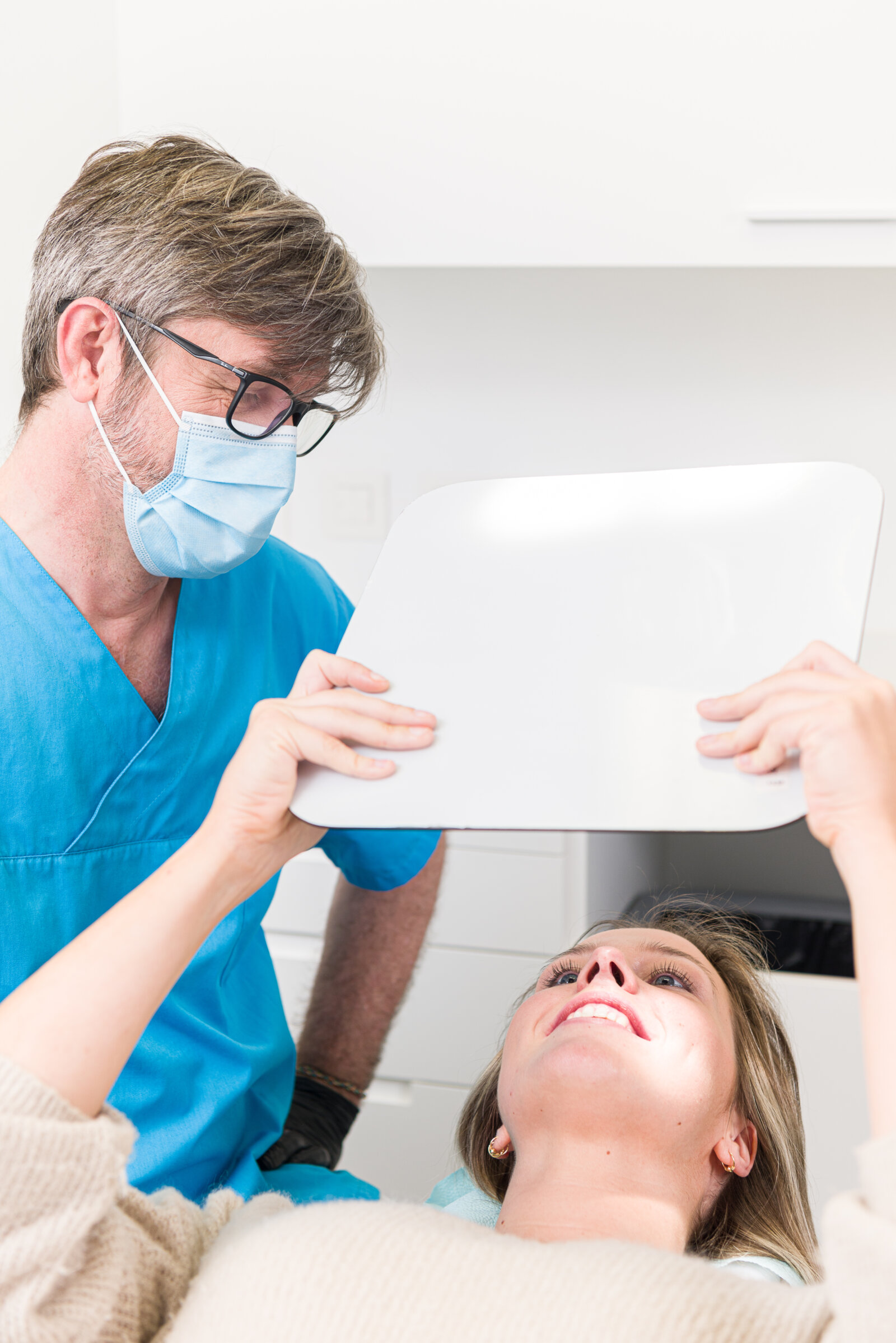
Types of bleaching
Treatments using bleach can be performed in different ways, depending on the patient's individual situation and wishes. We have the option of using 3 different methods for re-whitening your teeth:
- Home bleaching
This is the most widely used and recommended treatment. There are 3 stages:
- During the initial treatment, the teeth are checked to see if there are any cavities and then cleaned if necessary. If everything looks healthy, we then take impressions of the teeth. Based on these impressions, individual bleaching braces made from transparent plastic are created in the dental lab. These fit nicely over your teeth and include an extra small space for the bleaching product.
- After a few days, you need to return to the practice to try on the braces. At this stage, we will check the fit and attachment of them to ensure the bleaching product does not leak out and to enable optimal performance of the bleaching product.
- Once the braces fit properly, you will be provided with further instructions on how to safely whiten your teeth yourself at home (hence why the process is called home bleaching). This will usually be carried out for the 2 weeks that follow the previous step, although additional weeks can be added, depending on the desired result. The new products ensure that the procedures often only need to be carried out for 1 hour a day, although in some cases we may recommend doing it for a full night.
The great advantage of home bleaching is that you, as the patient, can decide – in consultation with the dentist – how light you wish your teeth to become (within the limits of feasibility). Furthermore, you can keep these braces and reuse them after 6 to 12 months to maintain the new tooth colour. After several months, the initial result will always fade slightly as a result of drinking tea or coffee, smoking cigarettes, etc.
- In-practice bleaching
With this, the complete treatment is carried out at the practice (hence why it is called in-practice bleaching). As part of the process, we apply the bleaching product directly to the teeth after making sure that the gums are properly shielded. This ensures there is no chance of irritation or making your gums feel sensitive. Afterwards, we activate the product using a plasma lamp and heat so that we can accelerate the bleaching process. Your dentist then repeats the process 2, 3 or 4 times during this one treatment, which will take about 1.5 to 2 hours. This treatment is slightly more expensive, but gives faster results. The cost of this treatment also includes a set of bleaching braces to help maintain and even optimise the result at home.
For very stubborn, often internal discolourations, this process might not be sufficient, which is why we also offer in-practice laser bleaching. These treatments are performed at MOND by Professor Roeland De Moor. Unlike a plasma lamp, a laser can penetrate deeper into the tooth to achieve better results. We also use this treatment when only 1 or more teeth need to be bleached so that they can be returned to the same colour as your other teeth. For this type of stubborn discolouration caused by trauma or antibiotics, we recommend that you make an appointment to see Prof. De Moor.
- Non-vital whitening, walking bleach method
This type of treatment is used for single dark areas of discolouration on an incisor that are a result of trauma or a previous root canal treatment. Damage to the nerve and blood flow to the tooth can cause it to suddenly turn grey or dark yellow in colour. If the filler material used in an (old) root canal was incorrectly positioned, it can also result in discolouration of the crown.
As part of this treatment, the dentist makes a small opening on the inside of the tooth, whereupon they insert the bleaching product into the tooth and leave it sealed up for several days. The tooth is therefore whitened from the inside. Depending on the type of discolouration, the treatment may need to be repeated several times. It can also sometimes be tricky to match the colour exactly to the colour of your other teeth, so the result could possibly be a little too light or too dark. This can be rectified afterwards through home bleaching.
Contact your dental practice to find out which bleaching treatments are offered.
Is bleaching painful?
A properly performed bleaching treatment is not necessarily painful, but it might sometimes cause sensitivity or irritation. There are a number of possible causes for this:
- Too much product is inserted into the brace, causing it to leak on to the gums and roots
- Some teeth have exposed necks (the part of the tooth directly between the crown and the root), which are not protected by tooth enamel or gums
- Cracks in teeth, allowing the product to penetrate deeper into the nerve
- Cavities due to tooth decay or poor fillings that were not noticed at the time of inspection
If you experience any sensitivity or pain, the best course of action is to contact your dentist who can adjust the braces, check the amount of product being used, or change the frequency and duration of the bleaching. Some patients may also be advised to use a toothpaste designed for sensitive teeth before, during and after bleaching.
Is bleaching bad for your teeth?
The simple answer is no! Bleaching is a safe and efficient method used to achieve a nicer, lighter tooth colour in a non-invasive manner. However, you should keep the following in mind:
- Hydrogen peroxide is a mild acid. Albeit temporarily and at a microscopic level, it makes the tooth enamel a little more porous in order to oxidise the pigments. This means that you should not clean your teeth with a brush after a bleaching process so that your saliva can help the tooth enamel to remineralise. Any brushing of teeth is always done before bleaching. The fluoride in toothpaste also helps with the remineralisation process.
- Excessive treatments On average, we recommend that the process lasts for 2 to 4 weeks. If we bleach the teeth for too long, the enamel may not recover sufficiently, which could result in a glassy, more porous appearance or cause localised white spots. If you wish to continue bleaching after a period of 2 weeks, we recommend that you have a check-up with your dentist to assess the risk.
- Gum irritation can occur as a result of poorly fitting braces or using too much product. If this problem persists, you should contact your dentist who will check the braces and dosage being used.
Why choose to have bleaching done at your MOND dental practice?
The active ingredient used to lighten the colour of teeth is hydrogen peroxide. It comes in various formulations, with the active concentration of hydrogen peroxide not exceeding 6% in accordance with European legislation. These products should only be used under the supervision of a dentist.
So-called “bleaching salons” who offer these treatments either use much lower concentrations of hydrogen peroxide that are therefore ineffective, or might even potentially use illegal and unsafe products to achieve a partial result.
This is why we would like to reiterate how important it is to have a bleaching procedure performed under the supervision of a dentist. The current legislation does not allow us to list the prices of treatments on the website, but to find out more, please contact the MOND dental practice of your choice.
Recover you smile
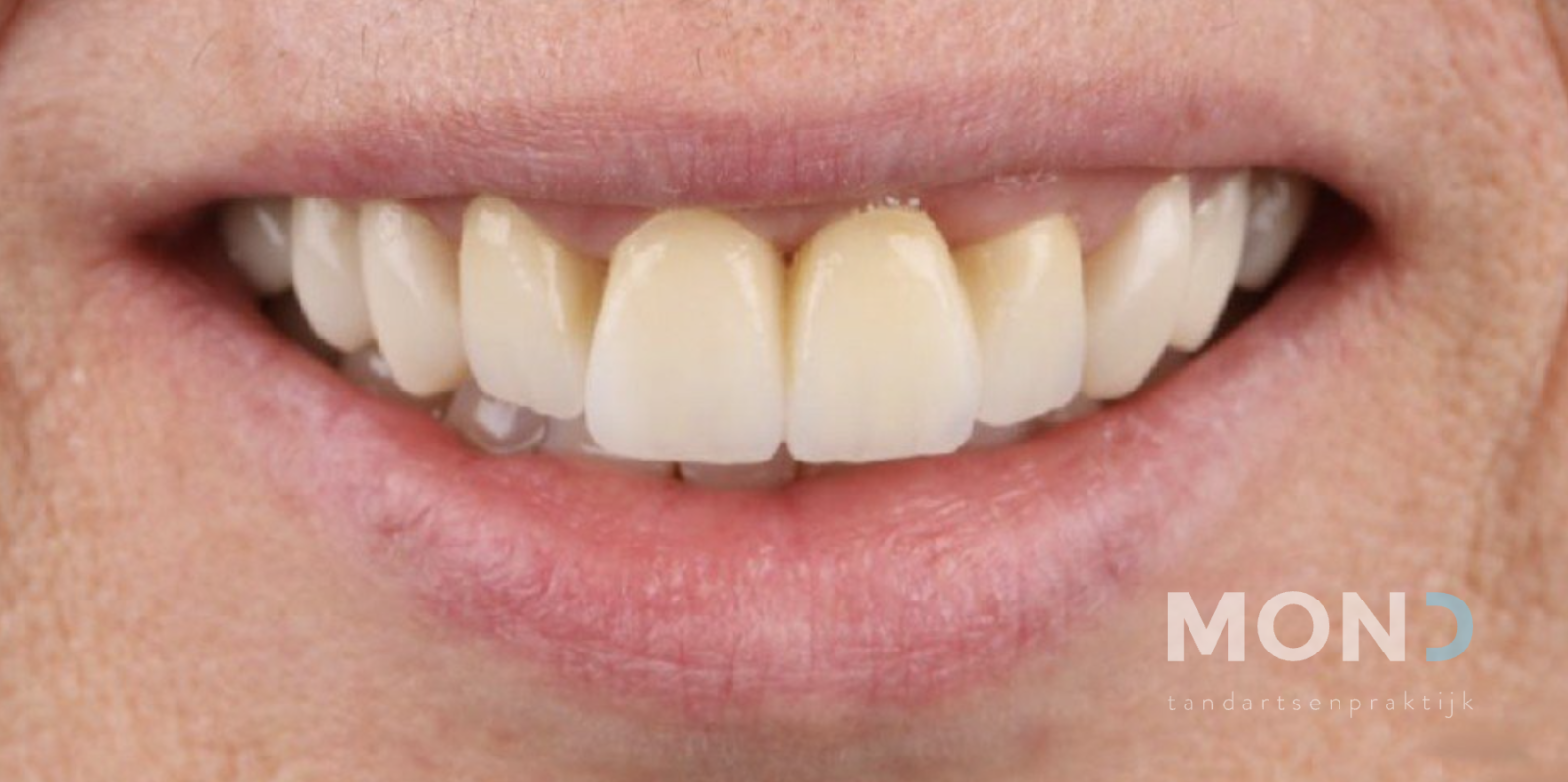
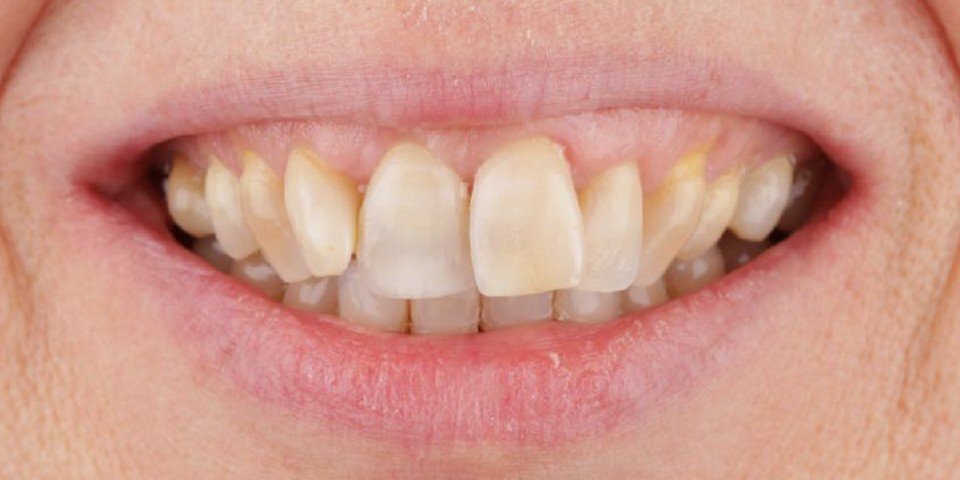
Bridge work, bleaching and veneers to correct tooth position and smile
Discover this smile | Bridge work, bleaching and veneers to correct tooth position and smileIs a bleaching something you’re interested in?
Check out the practices that offer bleaching below:
MOND Groen Kwartier
Pater Pirestraat 50,
2018 Antwerpen
MOND Paro Plus
Louis Marcelisstraat 25a,
1970 Wezembeek-Oppem

